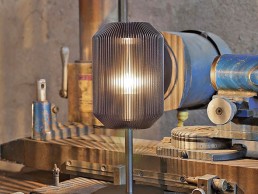
EOQ Collection
EOQ is a lighting company rooted in the spirit of industrial adventure, it delivers classic design principles using a new and constantly evolving vocabulary. Brand Director Matt Pepper took time out of his busy schedule to talk us through their processes and why working with aluminium is a surprisingly flexible and sustainable solution.
How and why did EOQ begin working with Aliminum?
Michael Young and I founded EOQ to create a platform for selling his celebrated Chair, 4a – an aluminum chair developed for a small restaurant project that had received a lot of attention due to the way it married form and function so elegantly. Developing this chair and the Bramah lighting range took us on a journey together along with an aluminum factory we both had close ties to, which happened to specialise in highly engineered components for the electronics industry. We all understood the material but every process and development for these products was new territory for everyone involved. This context has driven an innovative approach from the start.
Why is aluminum important to EOQ as a brand?
It is not only the world’s most abundant metal, it is non-toxic, rust proof and infinitely recyclable. It is also one third of the weight of steel and once alloyed it is stronger. We work with recycled raw material which, when designing products offers us a large range of production processes and finishes.
Could you talk us through the design and manufacturing process of your first ever product?
For our first pendant light Bramah we took inspiration from a heat sink. We spent some time studying the optimum extrusion dimensions and calculating our best guess initially at how thin and how many fins we could practically manufacture to create the lightest and most refined design. We have worked exclusively with Michael Young Design Studio for the first few collections who have been invaluable in defining the products in the context of the factory and its expertise and capability.
Michael knew he wanted to try and remove the core of the material to open up the structure and create the transparency needed to allow the light to diffuse through the fin, but that this wasn’t something that had been done before, so the process was challenging. Having discovered it was possible to kill out the core material to open up the fins and allow that transparency, we soon discovered that such fine aluminium fins did not respond well to the vibrations created by spinning at speed on a lathe. Many long weeks were spent refining the process to include packing the spaces between the fins with gypsum to reduce vibrations and wastage in the milling process. All of our lighting is predominantly made of aluminium, Bramah, Joseph and Dub.
How well does aluminium interact with glass?
It’s not so much that aluminium interacts differently with glass compared to other metals, it’s the surface treatment / finish that we can apply that works so well with glass. All of our products are anodised to a very high standard; this finish allows us to deliver any colour and a reflection that creates a synergy with the properties of glass.
How do the different treatments and finishes of this material affect how it interacts with light?
When the anodised finish interacts with light it causes a soft reflection that disperses across all the surfaces and delivers the light throughout the whole product.
What’s next for EOQ and aluminium?
We are midway through developing a new range of lighting with a very talented British designer using a simpler extrusion and I’m quite excited about the application of our anodising on a larger surface.



